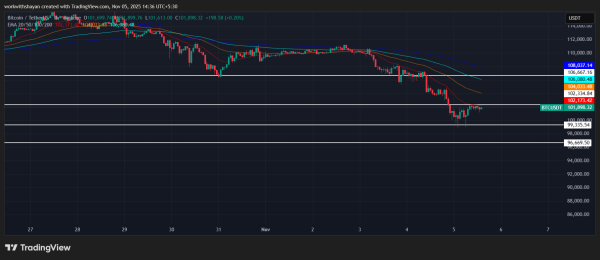First Mastercard Credit Card Settlement Pilot Using Ripple’s RLUSD Launches on XRP Ledger

Ripple entered a high profile collaboration with Mastercard, WebBank and Gemini to bring stablecoin based credit card settlements to the XRP Ledger using RLUSD.
The plan, revealed during Ripple Swell 2025 in New York, is to let Mastercard and WebBank ettle card transactions faster and with less friction by using Ripple’s NYDFS-regulated stablecoin, RLUSD, as the settlement asset. This is one of the clearest examples of blockchain infrastructure being plugged directly into traditional card rails, which strengthens Ripple’s pitch to institutions.
RLUSD Settlement Turns XRPL Into A Card-Grade Payment Rail
The initiative focuses on using RLUSD to settle between Mastercard and WebBank, the issuer of the Gemini credit card, over XRPL. Once live, it would rank among the first instances of a regulated U.S. bank handling fiat card settlement over a public blockchain with a regulated stablecoin. This shows that XRPL’s speed and finality can support real financial traffic, not just crypto transfers, and it narrows the gap between on chain rails and bank pipes.
Ripple said the move highlights its growing influence inside modern payment systems. By using XRPL’s low cost and fast confirmations, banks can reduce intermediaries, improve liquidity timing and gain more transparent settlement data. This makes XRPL more than a token network and positions it as a settlement backbone that regulated finance can actually use.
RLUSD itself is backed by cash and cash equivalent reserves under a New York Department of Financial Services regime and has already crossed $1 billion in circulation. The scale matters because it proves there is enough regulated stablecoin float to support card level settlement. It also pushes more volume across the XRP Ledger, which lifts the whole ecosystem.
Partnership Extends Mastercard’s Regulated Blockchain Push
This collaboration builds on earlier work between Ripple, Gemini and WebBank to bring digital assets into banked products. It also fits Mastercard’s longer program to modernize its network with compliant blockchain solutions instead of unregulated tokens. That is why this tie up is significant for banks watching the space. It shows that regulated card brands are willing to test public chain settlement when the asset, the issuer and the participants are all inside compliance.
Ripple President Monica Long said XRPL’s scale plus RLUSD’s compliance design can give financial institutions an efficient, transparent settlement track. If this pilot proves smooth, it gives other banks a pattern to follow, which could multiply XRPL anchored settlement use cases across regions. That would push more institutional activity onto XRP infrastructure.
Analysts Say XRP Utility Story Gets Stronger

Source: X
After the announcement traders started to look at what this means for XRP price over time. Market watchers such as Income Sharks said short term volatility may still give entries near recent levels for traders who missed XRP below $2. XRP is trading around $2.35, up 6% on the day, with a market cap near $145 billion.
 Bitcoin
Bitcoin  Ethereum
Ethereum  Tether
Tether  XRP
XRP  USDC
USDC  Solana
Solana  TRON
TRON  Lido Staked Ether
Lido Staked Ether  Dogecoin
Dogecoin  Figure Heloc
Figure Heloc  Cardano
Cardano  WhiteBIT Coin
WhiteBIT Coin  Bitcoin Cash
Bitcoin Cash  Wrapped stETH
Wrapped stETH  Wrapped Bitcoin
Wrapped Bitcoin  USDS
USDS  Wrapped eETH
Wrapped eETH  Binance Bridged USDT (BNB Smart Chain)
Binance Bridged USDT (BNB Smart Chain)  Chainlink
Chainlink  Monero
Monero  WETH
WETH  LEO Token
LEO Token  Zcash
Zcash  Stellar
Stellar  Hyperliquid
Hyperliquid  Coinbase Wrapped BTC
Coinbase Wrapped BTC  Ethena USDe
Ethena USDe  Litecoin
Litecoin  Sui
Sui  Avalanche
Avalanche  Hedera
Hedera  sUSDS
sUSDS  Shiba Inu
Shiba Inu  USDT0
USDT0  Dai
Dai  Canton
Canton  Uniswap
Uniswap  PayPal USD
PayPal USD  Mantle
Mantle  Cronos
Cronos  Toncoin
Toncoin  World Liberty Financial
World Liberty Financial  Ethena Staked USDe
Ethena Staked USDe  Polkadot
Polkadot  USD1
USD1  Aave
Aave  Rain
Rain  Bitget Token
Bitget Token  MemeCore
MemeCore  Tether Gold
Tether Gold  OKB
OKB  Falcon USD
Falcon USD  Bittensor
Bittensor  NEAR Protocol
NEAR Protocol  Ethereum Classic
Ethereum Classic  Binance-Peg WETH
Binance-Peg WETH  Jito Staked SOL
Jito Staked SOL  BlackRock USD Institutional Digital Liquidity Fund
BlackRock USD Institutional Digital Liquidity Fund  Pi Network
Pi Network  Pepe
Pepe  Aster
Aster  Internet Computer
Internet Computer  syrupUSDC
syrupUSDC  Ethena
Ethena  HTX DAO
HTX DAO  Jupiter Perpetuals Liquidity Provider Token
Jupiter Perpetuals Liquidity Provider Token  PAX Gold
PAX Gold  Midnight
Midnight  Global Dollar
Global Dollar  Sky
Sky  Circle USYC
Circle USYC  KuCoin
KuCoin  Ripple USD
Ripple USD  BFUSD
BFUSD  Binance Bridged USDC (BNB Smart Chain)
Binance Bridged USDC (BNB Smart Chain)  syrupUSDT
syrupUSDT  Worldcoin
Worldcoin  Rocket Pool ETH
Rocket Pool ETH  Ondo
Ondo  Aptos
Aptos  Gate
Gate  Binance Staked SOL
Binance Staked SOL  Wrapped BNB
Wrapped BNB  Pump.fun
Pump.fun  POL (ex-MATIC)
POL (ex-MATIC)  Quant
Quant  Arbitrum
Arbitrum  Official Trump
Official Trump  Algorand
Algorand  Function FBTC
Function FBTC  Lombard Staked BTC
Lombard Staked BTC  Solv Protocol BTC
Solv Protocol BTC  Filecoin
Filecoin  Cosmos Hub
Cosmos Hub  NEXO
NEXO  VeChain
VeChain  Liquid Staked ETH
Liquid Staked ETH  USDtb
USDtb  Superstate Short Duration U.S. Government Securities Fund (USTB)
Superstate Short Duration U.S. Government Securities Fund (USTB)  OUSG
OUSG  USDD
USDD  WrappedM by M^0
WrappedM by M^0  Janus Henderson Anemoy AAA CLO Fund
Janus Henderson Anemoy AAA CLO Fund  Beldex
Beldex  Sei
Sei  Mantle Staked Ether
Mantle Staked Ether  Arbitrum Bridged WBTC (Arbitrum One)
Arbitrum Bridged WBTC (Arbitrum One)  Ondo US Dollar Yield
Ondo US Dollar Yield  Polygon Bridged USDC (Polygon PoS)
Polygon Bridged USDC (Polygon PoS)  clBTC
clBTC  Bonk
Bonk  Render
Render  Renzo Restaked ETH
Renzo Restaked ETH  Wrapped Flare
Wrapped Flare  USDai
USDai  Polygon PoS Bridged DAI (Polygon POS)
Polygon PoS Bridged DAI (Polygon POS)  PancakeSwap
PancakeSwap  Kinetiq Staked HYPE
Kinetiq Staked HYPE  L2 Standard Bridged WETH (Base)
L2 Standard Bridged WETH (Base)  Jupiter
Jupiter  Jupiter Staked SOL
Jupiter Staked SOL  StakeWise Staked ETH
StakeWise Staked ETH  Pudgy Penguins
Pudgy Penguins  MYX Finance
MYX Finance  Usual USD
Usual USD  Story
Story  tBTC
tBTC  Optimism
Optimism  Arbitrum Bridged WETH (Arbitrum One)
Arbitrum Bridged WETH (Arbitrum One)  Bridged Wrapped Ether (Pundi AIFX Omnilayer)
Bridged Wrapped Ether (Pundi AIFX Omnilayer)  Curve DAO
Curve DAO  Spiko EU T-Bills Money Market Fund
Spiko EU T-Bills Money Market Fund  GHO
GHO  TrueUSD
TrueUSD  Dash
Dash  Lido DAO
Lido DAO  Artificial Superintelligence Alliance
Artificial Superintelligence Alliance  Ether.fi
Ether.fi  GTETH
GTETH  Tezos
Tezos  Virtuals Protocol
Virtuals Protocol  Injective
Injective  Stacks
Stacks  AB
AB  Aerodrome Finance
Aerodrome Finance  Merlin Chain
Merlin Chain  SPX6900
SPX6900  Stader ETHx
Stader ETHx  pippin
pippin  Ether.Fi Liquid ETH
Ether.Fi Liquid ETH  Marinade Staked SOL
Marinade Staked SOL  Wrapped ApeCoin
Wrapped ApeCoin  Audiera
Audiera  Celestia
Celestia  Swell Ethereum
Swell Ethereum  Starknet
Starknet  The Graph
The Graph  JUST
JUST  FLOKI
FLOKI  sBTC
sBTC  BitTorrent
BitTorrent  Lorenzo Wrapped Bitcoin
Lorenzo Wrapped Bitcoin  Sun Token
Sun Token  Steakhouse USDC Morpho Vault
Steakhouse USDC Morpho Vault  Coinbase Wrapped Staked ETH
Coinbase Wrapped Staked ETH  Chiliz
Chiliz  Maple Finance
Maple Finance  IOTA
IOTA  DoubleZero
DoubleZero  Bitcoin SV
Bitcoin SV  Ethereum Name Service
Ethereum Name Service  Conflux
Conflux  Telcoin
Telcoin  Olympus
Olympus  Avalanche Bridged BTC (Avalanche)
Avalanche Bridged BTC (Avalanche)  Kaia
Kaia  Trust Wallet
Trust Wallet  AINFT
AINFT  EURC
EURC  dogwifhat
dogwifhat  Pyth Network
Pyth Network  Cap USD
Cap USD  Binance-Peg Dogecoin
Binance-Peg Dogecoin  crvUSD
crvUSD  Resolv USR
Resolv USR  Kinesis Gold
Kinesis Gold  Resolv wstUSR
Resolv wstUSR  Gnosis
Gnosis  ether.fi Staked ETH
ether.fi Staked ETH 